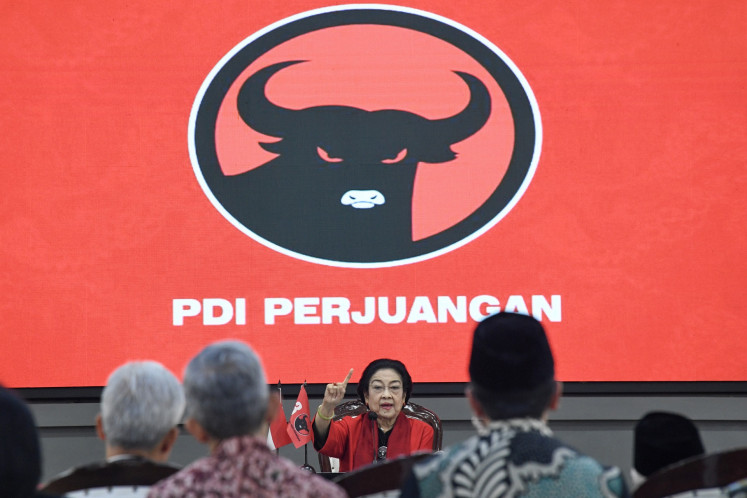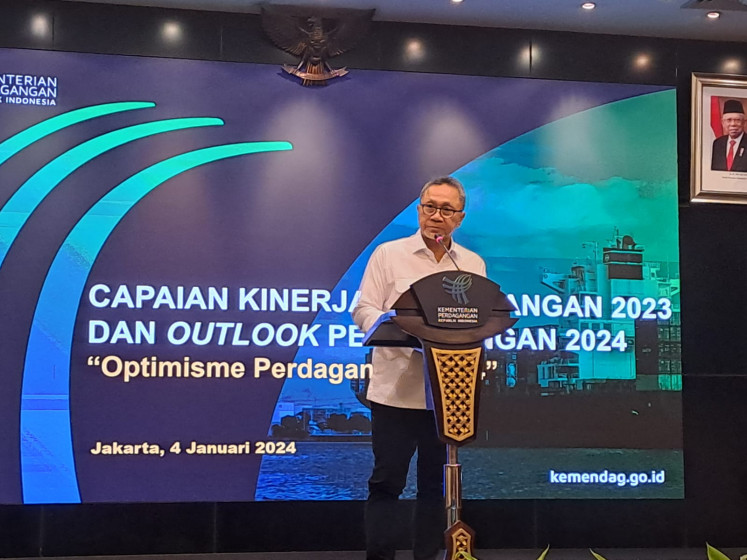Something for everyone
Though competition: A shop attendant shows the Acer Liquid S series, which has a 5
Change Size
 Though competition: A shop attendant shows the Acer Liquid S series, which has a 5.7 inch display, at a recent electronic show. The series aims to challenge the Samsung Galaxy Note in the phablet market. (JP/Nurhayati)" border="0" height="350" width="499">Though competition: A shop attendant shows the Acer Liquid S series, which has a 5.7 inch display, at a recent electronic show. The series aims to challenge the Samsung Galaxy Note in the phablet market. (JP/Nurhayati)
Though competition: A shop attendant shows the Acer Liquid S series, which has a 5.7 inch display, at a recent electronic show. The series aims to challenge the Samsung Galaxy Note in the phablet market. (JP/Nurhayati)" border="0" height="350" width="499">Though competition: A shop attendant shows the Acer Liquid S series, which has a 5.7 inch display, at a recent electronic show. The series aims to challenge the Samsung Galaxy Note in the phablet market. (JP/Nurhayati)Taken as an entertainment tool, large-sized tablets are being enjoyed by children while the working class takes advantage of various slate possibilities.
For work purposes or to simply kill time on the road, people still want large displays but are seeking tablets that are small enough to keep in their pockets or purses. The result is tablets and smartphones are moving in the same direction.
While smartphones are getting bigger to meet desire for multimedia purposes, giant vendors like Samsung and Apple are also shrinking tablets to 7 and 8 inches.
Vaksiandra Nuryadi, editor-in-chief of Forsel and Ponsel gadget magazines said that more Indonesians used their phones for Internet-based activity.
âNowadays, fewer and fewer people use their smartphones for making phone calls or texting. They like smartphones with a medium-sized display. Therefore, we often see the 5-inch phablet, or phone-tablet, these days,â Vaksiandra told The Jakarta Post.
The joy of large slates is not only for adults as it also affects the gaming and education habits of children.
Cinematographer Faozan Rizal said he bought an iPad for his children so that they wouldnât play with his gadgets.
âI bought my children an iPad so they can download games or education applications. Their iPad is synced to my gadgets, so whenever they download an application, it will also be downloaded to my tools,â he said. âI donât mind at all because when I get stuck waiting on a set, I can play some of my childrenâs games,â he continued with a laugh.
Aghia Khumaesi, who uses a Galaxy Tab, said all her five nephews and nieces were provided with tablets and iPads at home.
âTwo of them are in elementary school, while the remaining three are toddlers. Their parents gave them tablets and iPads because they all work,â she said.
Despite supplying them with mobile devices to play games, Aghia said that the parents applied time management with regard to gadget-use.
âThe children are allowed to play for only a few hours a day. The ones that are still in school need to wait until they finish their homework,â she added.
Apple has pioneered large slates with its iPad while continuing to produce its phenomenal touch-screen phone that has almost put keypad-based devises to extinction. The norm that Steve Jobs holds, however, is the strict division between phones and tablets and laptops with device synching.
The Apple paradigm was challenged in 2011 by Samsung, as the current global market leader, with the release of the Galaxy Note 3. The 5.3-inch tablet, equipped with a stylus, is still able to make calls, which is why it is called a phone-tablet or phablet. The term, ever since, is applied to any phone/tablets sizing 5 to 8 inches equipped with call features.
International Data Corporation (IDC) recorded that the Note series gained popularity in mature Asian markets like South Korea, Hong Kong and Singapore before becoming an instant hit in emerging markets, including Indonesia, with the phablet market becoming a battle field not only among big-name vendors but also the low-cost local players.
Apple, despite shrinking the size of iPad, until now is yet to make call features available for its tablets.
âIn emerging markets, where consumers may not have the budget to pick up one of each, the phablet is winning out to capture both the telephony and better browsing and multimedia experience,â says an IDC statement.
Product marketing manager for Samsung Mobile Febri Rusli said that, according to a GfK report, Samsung dominated the Indonesian smartphone market with a 48.5 percent share per December 2013. Meanwhile on tablets, Samsung covered 50 percent of market share as of December 2013.
âIt means that one out of two persons [in tablet market] uses a Samsung product,â said Febri.
Although the Apple iPhone might be seen as a rather new fun toy in most big cities in Indonesia, Vaksiandra said that the product wasnât the most-wanted item after Samsung items.
Apple products were exclusive in Indonesia as the brand still had no official representative office in the country, no marketing gimmicks, their products were quite pricey and offered fewer free applications, he explained.
âATSI [Indonesian Cellular Telecommunication Association] finds that the Smartfren Andromax series comes second after Samsung,â said Vaksiandra.
He learned that local brand Smartfren had changed its business strategy from only providing a network to producing mobile devices at affordable prices with dual SIM cards. âThis is the key to the success of Smartfren today.â
span class="inline inline-none">Though competition: A shop attendant shows the Acer Liquid S series, which has a 5.7 inch display, at a recent electronic show. The series aims to challenge the Samsung Galaxy Note in the phablet market. (JP/Nurhayati) Taken as an entertainment tool, large-sized tablets are being enjoyed by children while the working class takes advantage of various slate possibilities.
T
For work purposes or to simply kill time on the road, people still want large displays but are seeking tablets that are small enough to keep in their pockets or purses. The result is tablets and smartphones are moving in the same direction.
While smartphones are getting bigger to meet desire for multimedia purposes, giant vendors like Samsung and Apple are also shrinking tablets to 7 and 8 inches.
Vaksiandra Nuryadi, editor-in-chief of Forsel and Ponsel gadget magazines said that more Indonesians used their phones for Internet-based activity.
'Nowadays, fewer and fewer people use their smartphones for making phone calls or texting. They like smartphones with a medium-sized display. Therefore, we often see the 5-inch phablet, or phone-tablet, these days,' Vaksiandra told The Jakarta Post.
The joy of large slates is not only for adults as it also affects the gaming and education habits of children.
Cinematographer Faozan Rizal said he bought an iPad for his children so that they wouldn't play with his gadgets.
'I bought my children an iPad so they can download games or education applications. Their iPad is synced to my gadgets, so whenever they download an application, it will also be downloaded to my tools,' he said. 'I don't mind at all because when I get stuck waiting on a set, I can play some of my children's games,' he continued with a laugh.
Aghia Khumaesi, who uses a Galaxy Tab, said all her five nephews and nieces were provided with tablets and iPads at home.
'Two of them are in elementary school, while the remaining three are toddlers. Their parents gave them tablets and iPads because they all work,' she said.
Despite supplying them with mobile devices to play games, Aghia said that the parents applied time management with regard to gadget-use.
'The children are allowed to play for only a few hours a day. The ones that are still in school need to wait until they finish their homework,' she added.
Apple has pioneered large slates with its iPad while continuing to produce its phenomenal touch-screen phone that has almost put keypad-based devises to extinction. The norm that Steve Jobs holds, however, is the strict division between phones and tablets and laptops with device synching.
The Apple paradigm was challenged in 2011 by Samsung, as the current global market leader, with the release of the Galaxy Note 3. The 5.3-inch tablet, equipped with a stylus, is still able to make calls, which is why it is called a phone-tablet or phablet. The term, ever since, is applied to any phone/tablets sizing 5 to 8 inches equipped with call features.
International Data Corporation (IDC) recorded that the Note series gained popularity in mature Asian markets like South Korea, Hong Kong and Singapore before becoming an instant hit in emerging markets, including Indonesia, with the phablet market becoming a battle field not only among big-name vendors but also the low-cost local players.
Apple, despite shrinking the size of iPad, until now is yet to make call features available for its tablets.
'In emerging markets, where consumers may not have the budget to pick up one of each, the phablet is winning out to capture both the telephony and better browsing and multimedia experience,' says an IDC statement.
Product marketing manager for Samsung Mobile Febri Rusli said that, according to a GfK report, Samsung dominated the Indonesian smartphone market with a 48.5 percent share per December 2013. Meanwhile on tablets, Samsung covered 50 percent of market share as of December 2013.
'It means that one out of two persons [in tablet market] uses a Samsung product,' said Febri.
Although the Apple iPhone might be seen as a rather new fun toy in most big cities in Indonesia, Vaksiandra said that the product wasn't the most-wanted item after Samsung items.
Apple products were exclusive in Indonesia as the brand still had no official representative office in the country, no marketing gimmicks, their products were quite pricey and offered fewer free applications, he explained.
'ATSI [Indonesian Cellular Telecommunication Association] finds that the Smartfren Andromax series comes second after Samsung,' said Vaksiandra.
He learned that local brand Smartfren had changed its business strategy from only providing a network to producing mobile devices at affordable prices with dual SIM cards. 'This is the key to the success of Smartfren today.'
Smartfren Andromax smartphone series are priced from around Rp 900,000 (US$79.3), equipped with a dual-core processor, 1.2 GHz Qualcomm Snapdragon and 512 MB in RAM; to Rp 2.7 million, which is equipped with 5.5-inch monitor, Android OS 4.2 (Jelly Bean), Prosesor Quad-core 1.5 GHz.
'Some other data reveal that Sony Xperia or Nokia earns the second spot,' said Andra.
Sony has enjoyed a warm welcome in Indonesia due to its exclusive design as well as integrated business lines, such as Sony Music for and Sony Entertainment.
Marketing manager for Sony Mobile Communications Indonesia Ika Paramita said that users of her company's mobile products longed for a smartphone and/or tablet that combined superb design and superior entertainment technology within great performance.
'[Users want] products that allow them to play, watch, listen and create everything within the Sony world. They want to share such entertainment through user-friendly connectivity,' said Ika.
In the first quarter of 2014, Sony has introduced seven new products, including the Xperia Z2, Xperia M2, Xperia Z2 Tablet and SmartBrand SWR10.
In 2014, Samsung has globally introduced two new products: Galaxy Note Pro and Galaxy S5.
'Galaxy Note Pro has a 12.2-inch monitor with a 4 multi-window feature, which are dedicated for professionals in facilitating their needs of mobile and comfortable working experience,' said Febri.
Seeing the Indonesian smartphone and tablet market packed with Android, once market leader BlackBerry said that it wasn't focusing on luring customers from Android and iPhone, as it was focusing on being the most reliable end-to-end secure communication platform, from the device, network to the server level.
'In fact, with BlackBerry 10 OS 10.2.1, BlackBerry added support for Android Jelly Bean apps,' said BlackBerry Indonesia public relations manager Yolanda Nainggolan.
BlackBerry recently launched the BlackBerry Z3 smartphone, a new all-touch BlackBerry 10 smartphone designed with Indonesian customers in mind.
The new BlackBerry Z3 will feature a modern design with a 5-inch display while the new BlackBerry Z3 smartphone will have ccess to local apps and Indonesian contents.
Your Opinion Matters
Share your experiences, suggestions, and any issues you've encountered on The Jakarta Post. We're here to listen.
Thank You
Thank you for sharing your thoughts. We appreciate your feedback.









